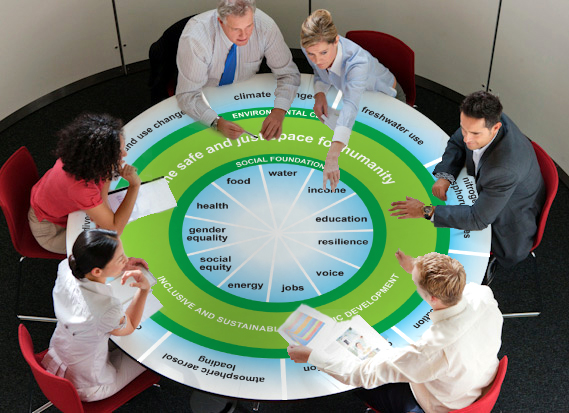|
Do you dare to doughnut in Davos?
by Kate Raworth

It's Davos time and the roundtable discussions are well underway. So here's the ultimate roundtable that I invite - or dare - every Davos CEO to take a seat at and tell their company's story.
The table is the Doughnut - the safe and just space for humanity - which lies between the planetary boundaries of Johan Rockstrom and his fellow scientists and the social boundaries that I crowd-sourced from the world's governments at Rio+20. Between those two sets of boundaries is no less than humanity's goal for the 21st century: to meet the human rights of up to 10 billion people while safeguarding the planetary life-support systems that sustain us all.
So here's how the CEO Doughnut Dialogues work. Every CEO - whether selling sun tan lotion or solar panels, seeds or tweeds, cars or bras - is invited to take a seat at the table and put their company's products at its centre. And then tell the story of those products – all the way from their design, sourcing, supply and sale to use and disposal – in terms of whether or not they are helping to bring humanity into the safe and just space between social and planetary boundaries.
The real question on the table, as put by a leading London brand agency: Is your brand a Doughnut brand - or on its way to becoming one?
There’ll be plenty to talk about, starting with your business today.
– Of all the nine planetary boundaries, which are the boundaries that your company's business and business model is really putting pressure on? (Intensive use of water? Driving large-scale land-use change? Heavy reliance on fossil fuels? Generating plastic or chemical waste?) And are there any boundaries for which your products are helping to reduce that pressure (Renewable energy technology, water-efficient household goods?)
– Of the eleven social boundaries, which ones does your business model have most impact on? (Are the women and men who make the products paid a living wage, and free to organise? What is the impact on consumers’ health and nutrition from consuming it?)
– Next, tell the story of your products' evolving social and environmental impact over the past ten years. How has your company improved its business practices over the last decade so that it has more positive impacts on the social dimensions, and simultaneously reduced pressure on planetary boundaries? Where, in contrast, have been the social and environmental steps backwards, pushing the products further out of the safe and just space.
– And then, importantly, tell the story of your company’s ambition over the coming ten years. In which dimensions could your company make transformative change both in improving its social impact and in reducing its ecological impact?
I can think of several companies that could proudly put their products on the doughnut table and tell an impressive story of the progress they have made, with an open and honest assessment of how far they still have to go. And I can think of plenty of other companies that would steer well clear and avoid a seat at all because the doughnut challenge would starkly reveal the extent to which their business model is operating outside of the boundaries on both sides.
Can this kind of visual exercise help drive commitment and action within companies? Yes. It is one of the core workshop tools we use at the Cambridge Institute for Sustainability Leadership, when working with senior executives from a wide range of multinational companies. In those workshops we explore not only how companies may be raising the pressure on social and planetary boundaries, but also how greater global pressure on those boundaries, in return, raises risks for your own business. And a good number of those companies have taken up the Doughnut in their in-house strategising.
So, Davos CEOs, who's up for a Doughnut Dialogue?...
Kate Raworth | January 20, 2015 at 9:05 pm | Categories: General | URL: http://wp.me/p3sUHn-nv
| 
